1-8 November 2021

This is our first attempt at foreign travel since the Covid pandemic – going to Hamburg to see our friend Gerhard (who we first met in Bequia many years ago and who lives in Hamburg); to further explore the delights of Hamburg; and to take in a mini excursion to Rostock on the Baltic coast.
Are we back to normal travel? Up to a point, Lord Copper. On the plus side - no Covid tests before going there; no quarantines; just proof of double vaccination. On the other hand – they do have a requirement to submit a form to the German authorities, equivalent to our ludicrous locator form but more sensible and easier to complete. In Germany there is much more rigorous enforcement of mask wearing than we have and, in many respects, they are getting back to normal more slowly than we are, as indicated below.
Hamburg
Our first day was a disappointment. All the guidebooks speak highly of the Rathaus (the town hall), built in High Renaissance style after a fire in the 1500s. We got there in good time for the English language guided tour. But no: the building was closed; only open on Saturday (when we won’t be in Hamburg). I assume this is Covid-related. The notices at the entrance show the normal entry times. We talk to a family of German visitors who are also wandering around in a bemused fashion. The uniformed official was not in communication mode.
In the afternoon I take off to see the St Michael’s church, which the guidebook says is the most wonderful baroque church in northern Germany. But I found that it was closed to visitors. One certainly couldn’t blame Covid. There was a service taking place. You can’t criticise the locals for using a church for what it’s intended for.
The second day was more satisfactory. I managed a visit to the St Michael’s church, when no service was in progress. We then both went to the local zoo. And I took in a visit to the fine art museum, to be repeated the following day with Mary. Let me record a few details of each, partly as an aide-memoir for me, so please bear with me if interest flags.
St Michael’s Church
The St Michael’s church is baroque, but not at all like the extravagantly decorated examples

in Bavaria. Here in Hamburg all is simplicity, I suppose to accord with the precepts of Martin Luther, a large, imposing, somewhat ferocious statue of whom stands outside. It is baroque in the sense that, horizontally, there are no straight lines, just swirling curves. It is unlike the Bavarian versions in that the walls and ceiling are largely undecorated and gleaming white. The pews are curiously arranged, maybe again to follow Luther, all facing the centre, not the altar, the better doubtless for hearing the words of the preacher from the amazingly curvaceous baroque pulpit (on the right).
Hagenbeck Zoo
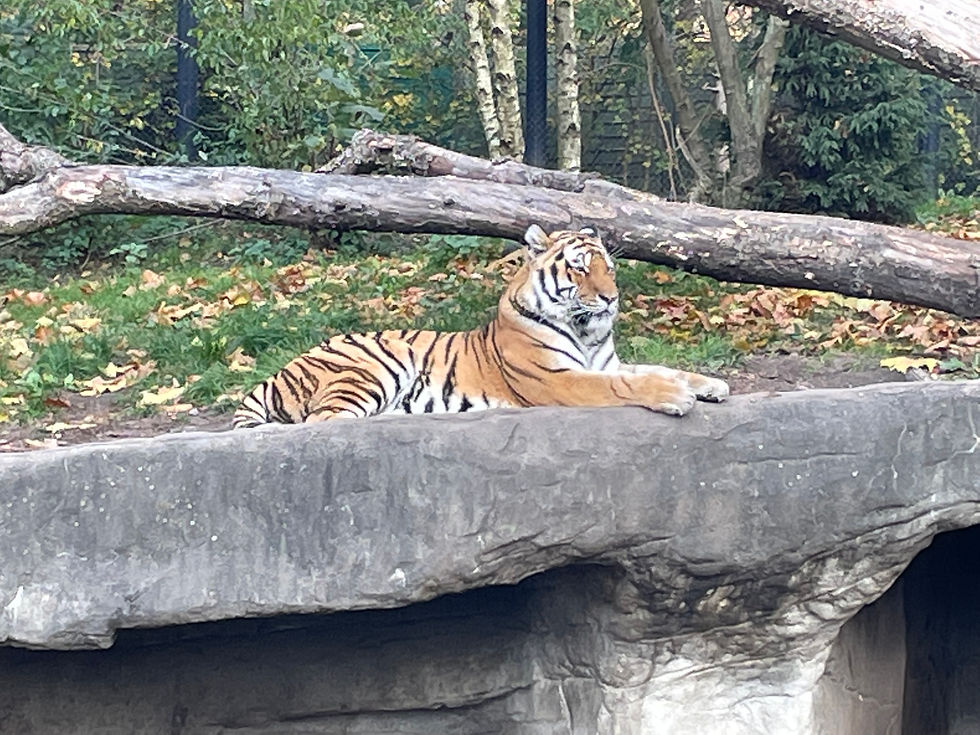
On to the zoo. The Tierpark Hagenbeck is wonderful and must be one of the top zoos in Germany. The animals seem to be roaming around in largely appropriate habitats, even though obviously in a city zoo they don’t get as much space as they do in the wild. Highlights included a magnificent Siberian tiger viewing his surroundings with an imperious eye; many walruses swimming around with apparent enjoyment; a couple of large porcupines; as well as the usual somnolent lion; and assorted antelope and deer. But the biggest surprise of all was a multitude of little prairie dogs from North America, all running happily around. They have their own special territory, allowing them to dig their deep tunnels.
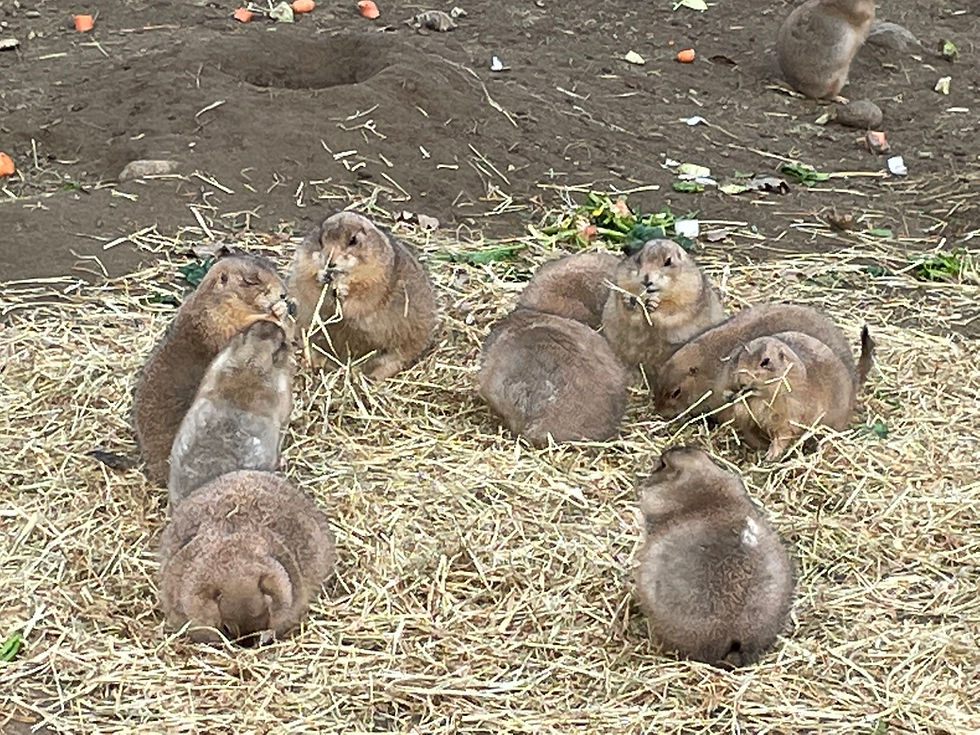
No monkeys for some reason – except for a solitary mandrill, which must be a kind of monkey.
The zoo was looking good and benefitting from the autumnal conditions. Early November may not be the best time of year to visit Hamburg. Evenings are drawing in early; the weather unpredictable (is it ever not?). But looking on the bright side, autumn has come sooner in Hamburg than in London. The trees are showing their magnificent golden colours – especially in the zoo. Curiously, the zoo has a strongly oriental appearance, with a Chinese (or Japanese, maybe) pagoda at the entrance; a Japanese bridge going over a small lake, presided over by a large Buddha. As I say, all this is beautifully set against the golden and rust coloured autumnal colours.
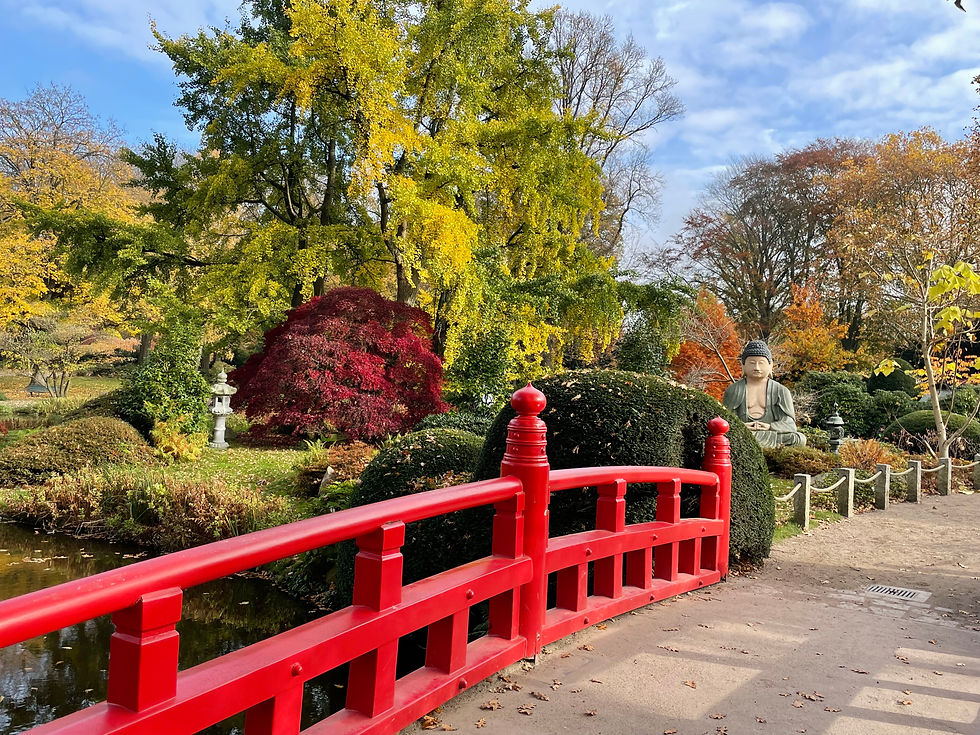
Fine Art Museum
The fine art museum is called the Hamburger Kunsthalle and visiting it is a happy experience. There is the usual requirement to show you’ve been vaccinated. There is also what I suppose is a test-and-trace system where the locals put their mobile phones against a QR device. If you don’t have the relevant app, you fill in a form, which people are very relaxed about and where the temptation to put in a wrong telephone number is (almost) irresistible. But the attendants (unlike some others, as described below) are friendly and helpful. They also say, amazingly, that you don’t have to wear masks: common sense reigns – the rooms are, after all, large with high ceilings – not, one would assume, a hotbed of disease.
The gallery has a fine collection, largely German. They explain that the founding fathers in the 19th century assembled the kind of paintings that, unsurprisingly, the rich and prosperous inhabitants of Hamburg liked and possessed, namely German, Dutch and Flemish works. Then, come the 20th century, they realised that they had missed the boat, certainly so far as Italian painting was concerned, but also French and the Impressionists. As a result, the accent is very much German. Interestingly, this includes Impressionists, where there are German Impressionists that compare pretty well against the few French examples they managed belatedly to get hold of.
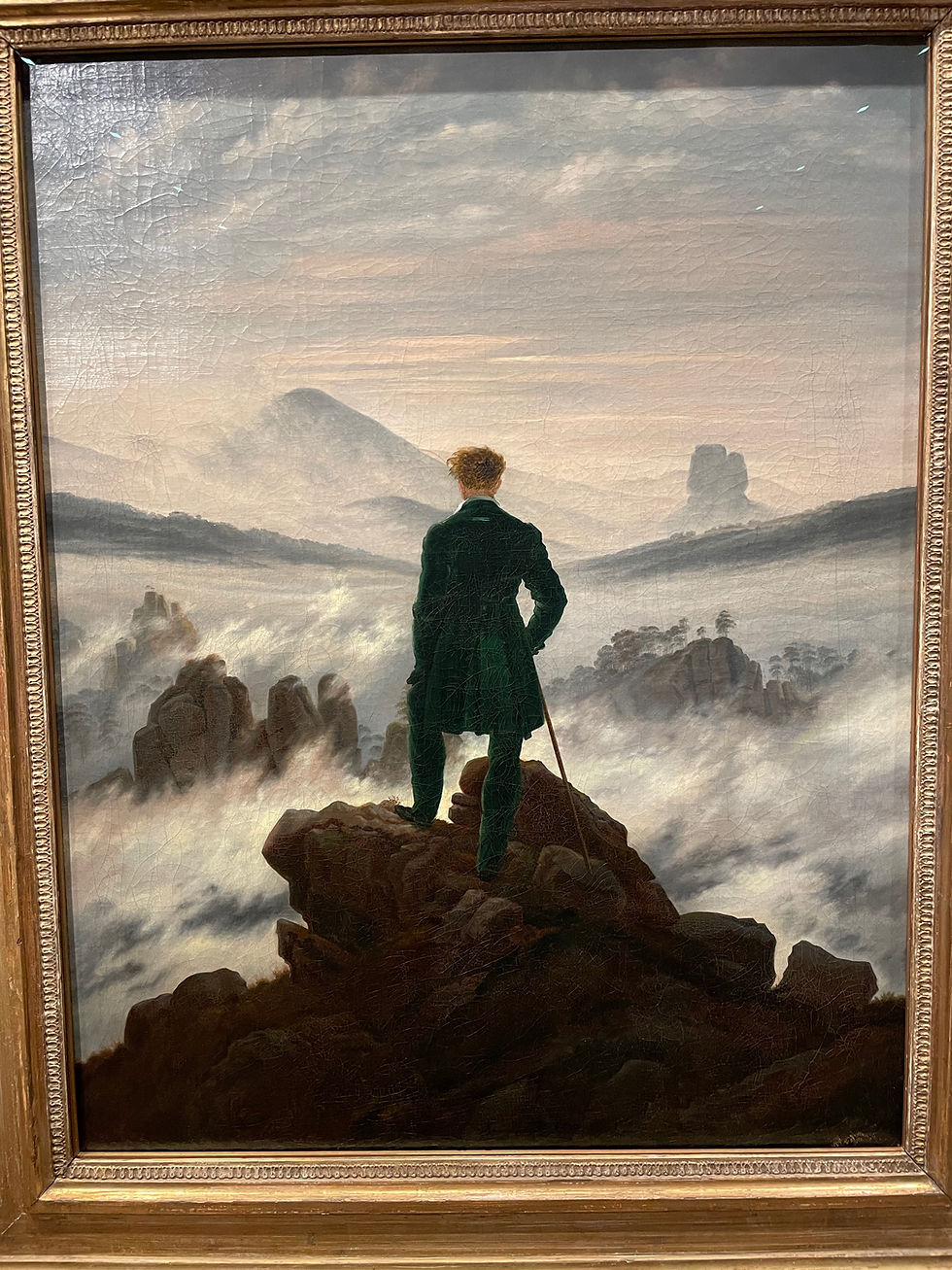
The highlights include the works of Caspar David Friedrich (1774-
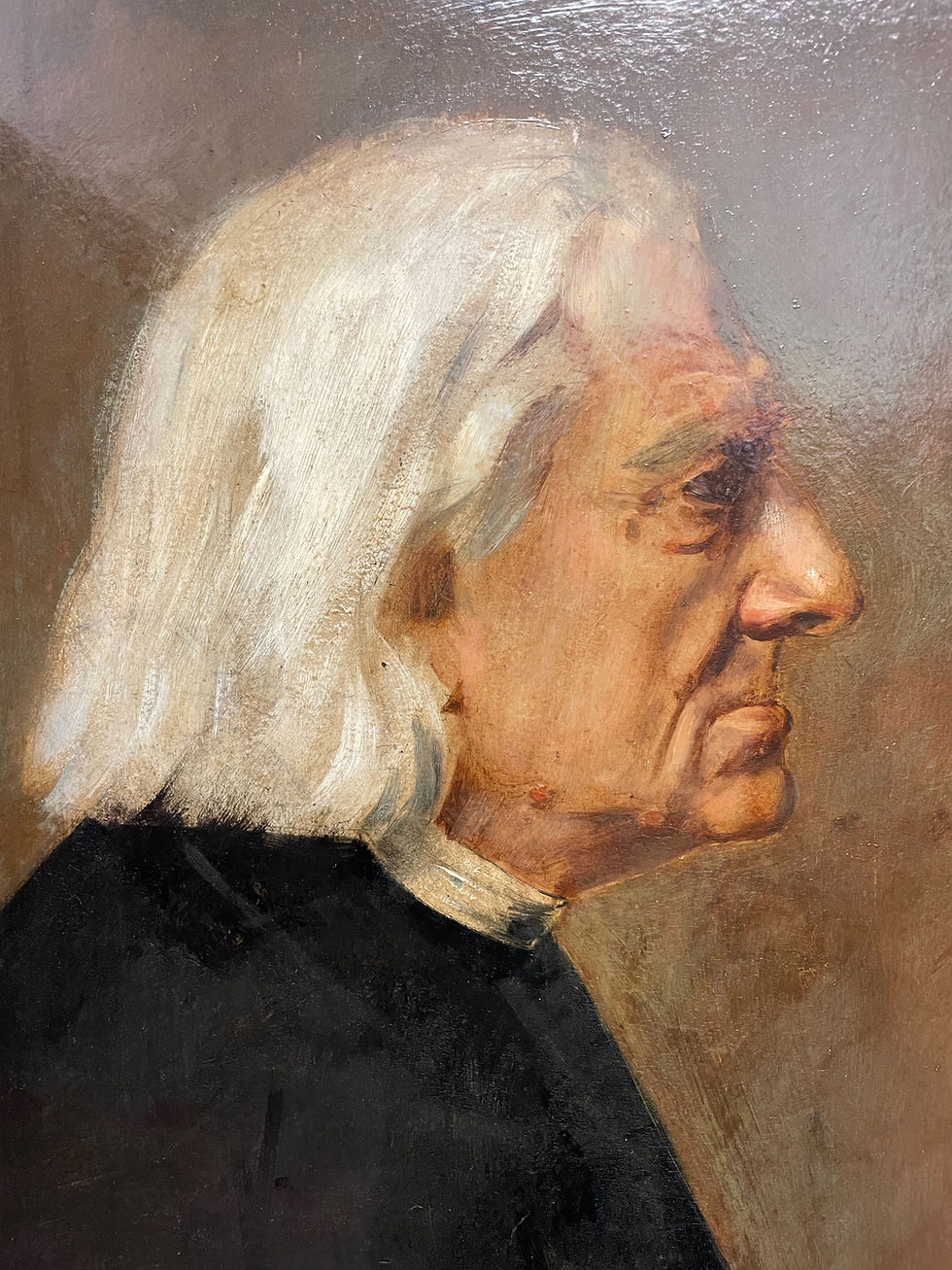
1840) and his famous, and mysterious, Wanderer above the Sea of Fog (see left). They have one of the best portraits I know of: one of Franz Liszt by Franz von Lenbach (see right). I also found myself much taken by the work of Lovis Corinth (1858-1925) one of whose paintings is a large portrait of Herr Hagenbeck, the founder of the zoo, patting affectionately one of the walruses that presumably were part of his zoo right from the start. Lovis Corinth is particularly good at walruses.

Restaurants
We sampled a wide range of Hamburg’s restaurants. For our first evening, Gerhard invited us to his lovely apartment, festooned with paintings, photographs, all sorts of memorabilia and the largest collection of CDs I ever remember seeing anywhere. He gave us a traditional light supper of wurst and salad, washed down by, frankly, excessively generous quantities of champagne and wine.
Next evening we went to his favourite bistro, a French restaurant called Plat du Jour, family-owned – of course – and excellent. Then, to an Italian, L’espresso Bar: neither a café nor a bar, but a good solid Italian restaurant. And finally, the Fischereihafen, which is well-known, even to us: a splendid, top of the market fish restaurant on the harbour front, again family-owned.
All of which tends to bring me to two of my quite distinct preoccupations: how good the food in Germany always is, even though this is largely unrecognised outside the country; and second, why it is that Germany seems to retain family-owned businesses, certainly in the hotel and restaurant sector, much more than we do.
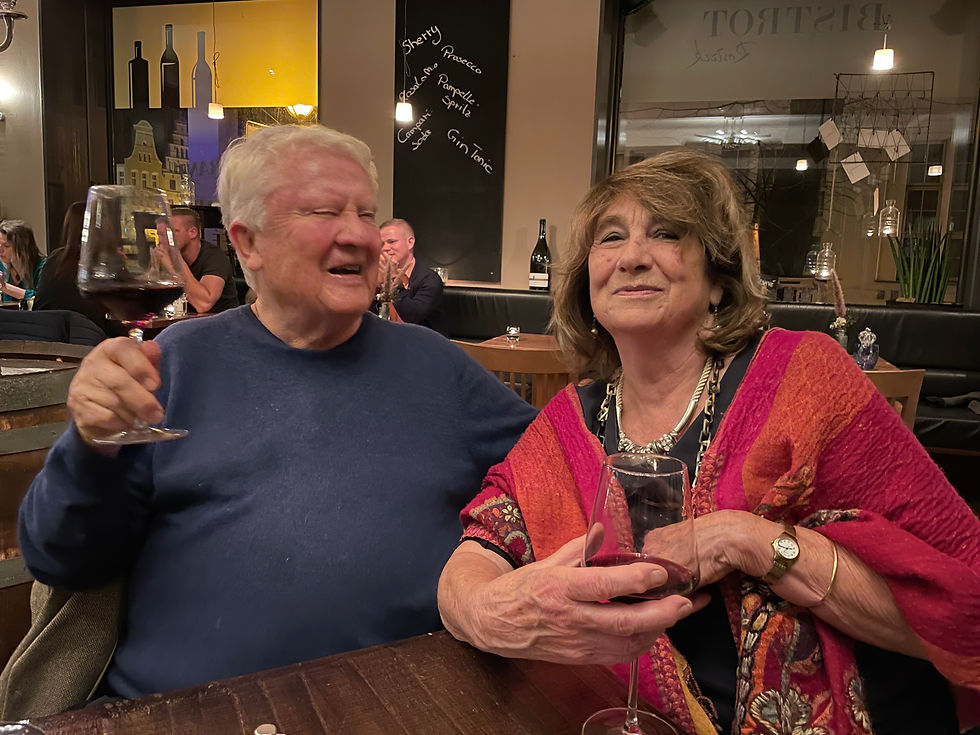
Rostock
Why Rostock? We wanted to see something near Hamburg, having already some years ago gone with Gerhard to Lübeck. He dissuaded us from anything very far afield and suggested we go to one or more of the other Hanseatic cities along the Baltic coast. We decided on Rostock with the possibility of seeing Wismar into the bargain. Rostock is the largest city (though not the capital) in the state of Mecklenburg-Vorpommern.
Rostock is about two hours by train from Hamburg – in an easterly direction and so, in Eastern Germany, the GDR, in the days of communism and before unification. Does this still show? In some respects, perhaps yes; but in the main, no, although it’s not the most exciting place in the universe.
Our hotel, the Vienna House Sonne, is pleasant enough, modest, four star, and absolutely central – just by the Neuer Markt, which is the hub of the city. The GDR aspects hit me most forcibly in the breakfast room: gloomy décor, and basic overhead lights. But the staff were delightful, friendly and helpful – exceptionally so. (Incidentally, Vienna House is a chain with several dozen hotels mainly in eastern Europe. The hotel was simply the Sonne, or the Steigenberger Sonne, till fairly recently.)
We managed to hit Rostock in the middle of Leucht Woche (Light Week). The whole place was seemingly deserted during the daytime, except for a small farmers’ market in the main square. But come evening, the local population arrived in force; the square full to bursting, all the shops open, and the restaurants and bars doing good business (see below!). They had come to see the lights and spectacular they were. The town hall was lit up in the most sophisticated way and appeared to be covered in trees; the ancient city gate was lit up like a birthday cake.

It must have been the effects of Light Week that caused us restaurant problems. We had a salad lunch at a salad and hamburger place called Alex. It was so good that we asked to book for dinner. Sorry, fully booked. What about tomorrow? Fully booked too. What was happening? We didn’t yet know about the Lights.
Fearing starvation, we hurriedly sped back to the hotel to get them to recommend somewhere. Great difficulty. The best we could do was a very late sitting at a harbour-side restaurant called Borwin. Borwin is essentially a fish restaurant, top quality, with the most pleasant, old fashioned, gemütlich, atmosphere imaginable. So we fell on our feet – certainly starvation was avoided.
Marienkirche
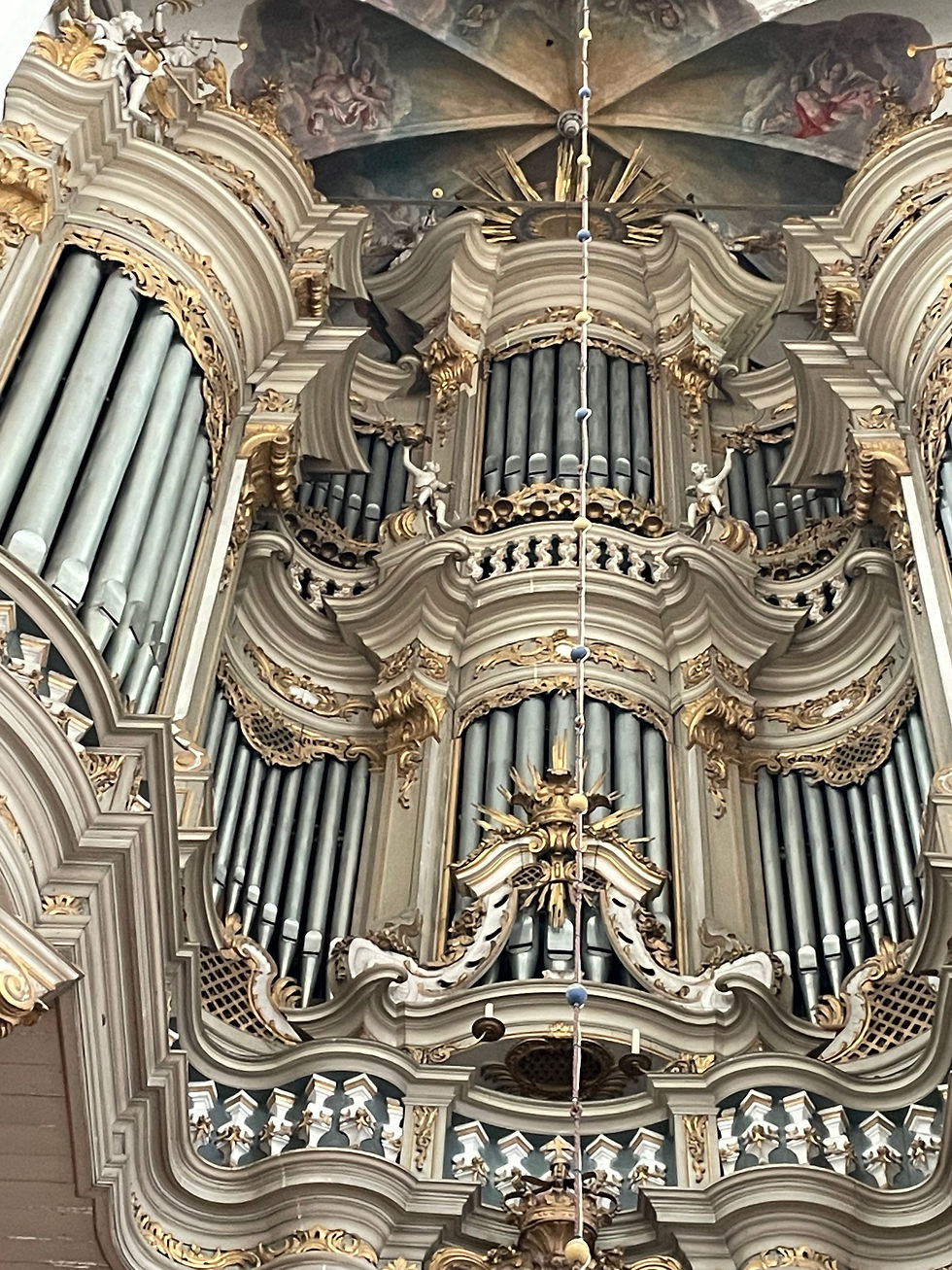
The Marienkirche in the centre of town was, in Gerhard’s words, worth the trip to Rostock. It is a magnificent example of the tall, redbrick, gothic churches that northern Germany is known for: tall, light nave, massive sculptured monuments, the biggest organ I have ever seen in my life, and an astronomical clock constructed in the 1600s after Galileo had explained that we go round the sun, not the other way round. It seems to have been programmed to record the dates, phases of the moon and whatever, up to the 21st century.
Then an encounter with a friendly Greek dog. We had spotted the dog lying outside the church, presumably waiting, very patiently indeed, for its owner to emerge. After examining the astronomical clock, we felt in need of a coffee. Just by the church there was a modest-looking building offering coffee and home-made cakes. We stepped in hesitantly, to be greeted by the kindly lady who runs it apparently for the benefit of a charity. Surprisingly we were then joined by the dog and its owners, she being Greek and having rescued the dog from Naxos. They tend to spend time in Crete, where as it so happens Mary’s daughter Henrietta has been living for the last few months.
The Münster at Bad Doberan
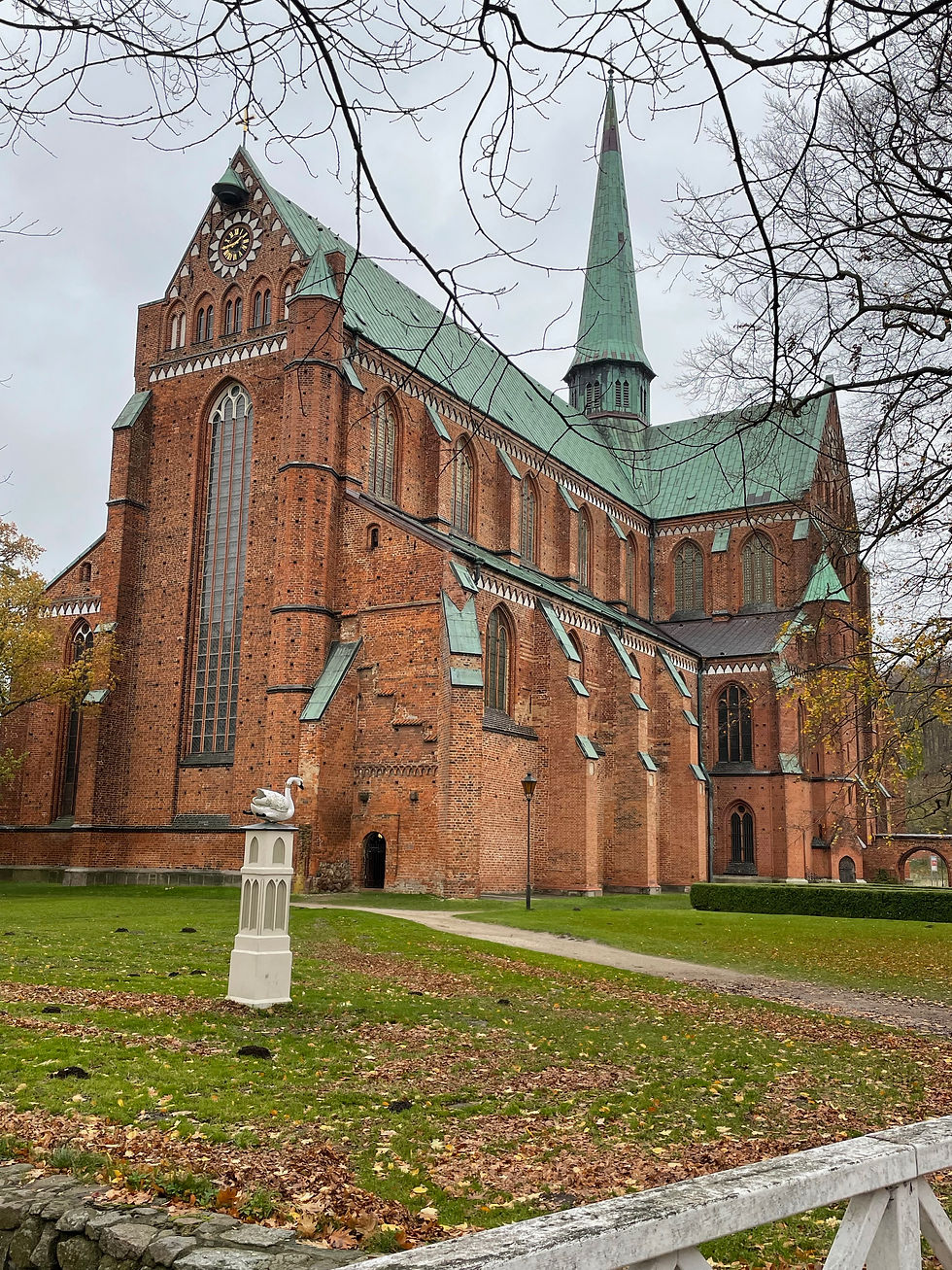
This is getting repetitive – another magnificent large redbrick gothic church, this time a relic from a monastery that was demolished long ago. This involved a 20 minute taxi ride out of town. It made the taxi driver’s day.
Wismar
Wismar is another ancient member of the prestigious Hanseatic League that dominated trading around the Baltic and the North Sea many hundreds of years ago. They still proudly regard themselves as Hansastädte (Hanseatic towns).
Wismar is much smaller than Rostock and better preserved. Mary opted out of this expedition: a train ride away from Rostock.
I went on Sunday when, typically, it seemed completely deserted – but this made it pleasant to see. As I’m getting used to, the main treasure of the city is an apparently amazing altarpiece in the church of St Nicholas – it was entirely covered in tarpaulin. But the small city was delightful to wander round. It shows some traces of the days when it was ruled by the Swedes. The most unusual of the buildings in the main square is the Old Swede (below).

German officials
I have to conclude with two incidents, both at Hamburg airport, which showed German officials in a bad light. I record this reluctantly as we have always found the Germans we meet (including officials) to be unfailingly friendly, charming and welcoming. It’s one of the reasons we like visiting Germany.
The first was minor. When I presented my passport to the passport control on arrival, the official spent a lot of time turning the pages and wanted to see my return ticket. I showed her my return flight details. She then looked at me ferociously and said that I could only stay for another 25-odd days in the Schengen area – presumably because of the post-Brexit limits. Not very welcoming! Actually not true, so far as I’m concerned, as I have a French residency permit, which she had no reason to know and was none of her business.
The second was worse – also at Hamburg airport. Do they train their officials to be unpleasant? Mary was going through the security checks and the official told her aggressively that her mask didn’t accord with the rules. No guidance or help was offered. Just “Get a proper mask” – “It’s your problem not mine”. Mary was almost in tears (I was already through). Luckily a kind fellow traveller gave her a compliant mask. Mary has a mask with a design on it and obviously had no idea it wasn’t adequate. Apparently the requirement is satisfied by a mask of the pale green type that I had always thought were completely useless (and still do) but that do in fact comply with the rules. But the point has nothing to do with masks. The point is that all these rules have the potential to turn people into monsters and Hamburg airport isn’t handling it well.
Tony Herbert
9 November 2021

Comments